Shawn Harris on A Polar Bear in the Snow
 January 12th, 2021 by jules
January 12th, 2021 by jules
It’s a pleasure to have a visit today from illustrator Shawn Harris, who discusses not only the genesis of A Polar Bear in the Snow (Candlewick), written by Mac Barnett and released at the end of 2020, but also how he created the illustrations for the book.
“There’s a polar bear in the snow. … Where is he going?” With engaging, appealing sentences and striking cut-paper artwork, the story brings readers a polar bear’s adventure, one of play and movement and joy.
I thank Shawn for sharing images and videos (all videos are captioned) about his artistic process. Let’s get right to it. …
Shawn: Hello again, Imps! Back in 2017, Jules welcomed me to make my debut 7-Imp appearance with some process images from my first picture book, Her Right Foot. As a footnote (ha?), I included a couple test images from a book that my oldest friend, Mac Barnett, and I were just beginning to work on, a book about a polar bear. Well, that book is now finished. Here’s the cover:

A Polar Bear in the Snow published by Candlewick in October of 2020.
And here’s proof of our old friendship:
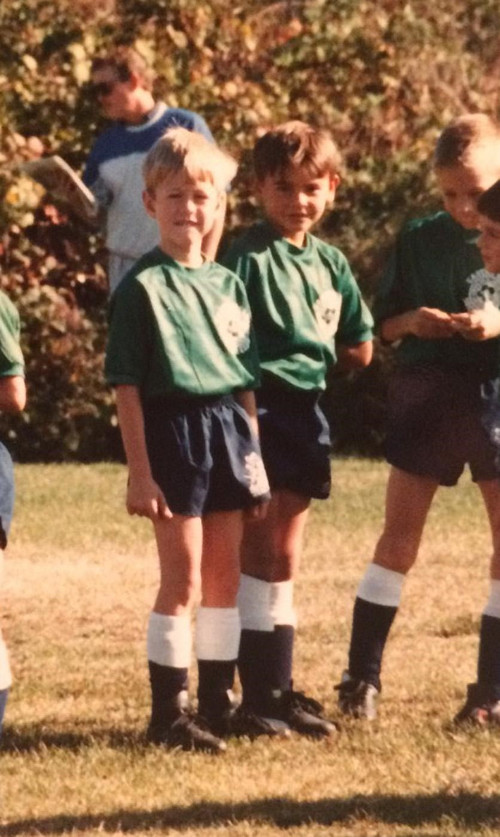
So, I have returned to share with you how these collages that premiered here three years ago turned out!
Our idea for Polar Bear began in Mac’s breakfast nook (before breakfast, fittingly). I was poring over proofs of Her Right Foot and was particularly excited about a page upon which the Statue of Liberty’s plain-white-paper crown overlapped her plain-white-paper arm.

There was such a tactile look to the print that I kept running my fingers over the paper, expecting to feel real dimension on the page. (This is a move I’ve since witnessed kids do with my books, and it delights me every time.)
I turned to Mac, who was slicing a peach, and said:
“Hey, wouldn’t it be great to do an entire book in monochrome, with the edges of objects defined only by the shadows they cast?”
“Oh cool.” He said. (He was more interested in the peach.)
“Like, imagine a book about a polar bear in the snow.”
He put down the knife. “That’s a good title. You should write it.”
“Okay.” I said. “Like, how would I start?”
“You say, ‘There is a polar bear in the snow. Still asleep, he lifts his nose to sniff the air — and he awakens.’”
“Oh cool,” I said. (And I meant it.) “Then what?”
“’There is a polar bear in the snow.’” He repeated. “’Where is he going? Is he going to visit the seals?’”
I imagined the smiling arctic characters, passing one another.
Mac picked up the paring knife. “’No. He is not hungry.’”
I burst out laughing in shock. Unwittingly, I’d been lulled by the comforting picture book cadence into anthropomorphizing the bear in my mind. With a deft flit of a sentence, Mac had done that thing he’s so good at doing, reminding us that picture books don’t have to avoid complexities of the real world to speak to kids. This bear was suddenly a real living creature, who may — on another day — have torn the blubber from a doe-eyed seal right before our eyes.
“Wow,” I said. “It feels like you just wrote a third of this book. Do you want to just finish it?”
He took a shower; we ate some sliced peaches and yogurt and drank espressos; and, after breakfast, I began sketching. Since the book’s energy comes from the relationships between Mac’s spare words and my pictures — relationships that may not have been clear in manuscript form — we thought it was important to pitch a full dummy.
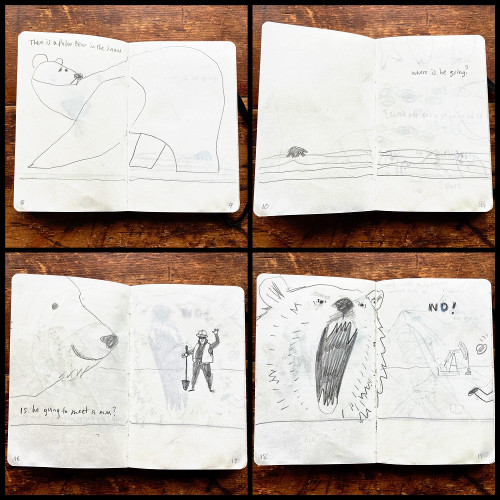
(Click image to enlarge)
This is what those sketches ended up looking like finished in the book:
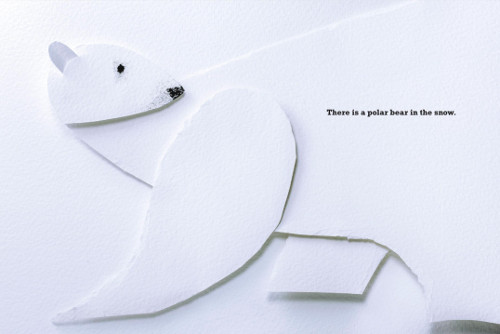
(Click spread to enlarge)

(Click spread to enlarge)
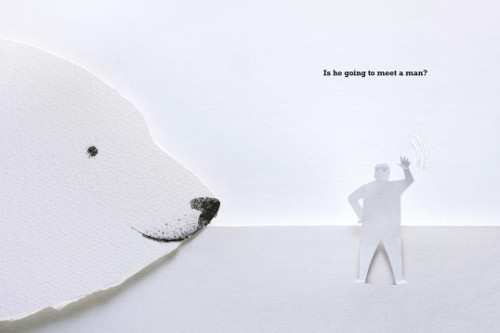
(Click spread to enlarge)

(Click spread to enlarge)
Yes, the whole book is illustrated in torn and cut white paper collage. Yes, even this very blue page:
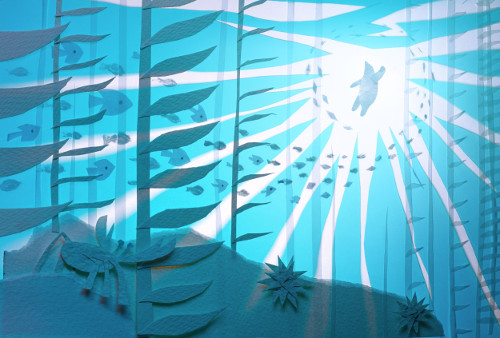
But let’s come back to that.
I found that the more dimension I could achieve with my collage, the more I could provoke the shadows to extend and define my scenes. Unlike the flat collages in Her Right Foot, I needed big shadows in lieu of contrasting colors — to make the pages pop. So, I built up layers of folded paper and used foam tape to raise layers of paper above my canvas. Sometimes it looked like an artless mess (until you saw the work from the right angle).
Okay, now what about the blue?
I photographed the work sitting on my light table in order to let the glimmering sea light up the art from behind:

Finally, I altered the color of the light, using a lighting gel, like a theater production would use to change the color of a stage. My canvas is thin vellum here, so the color passes through the “water,” but the bear and ice, cut from thicker watercolor paper, remain white:
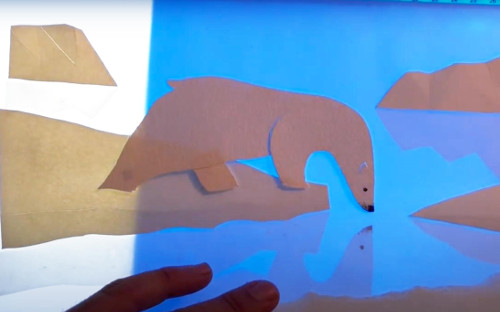
Here it is, photographed and ready to print:
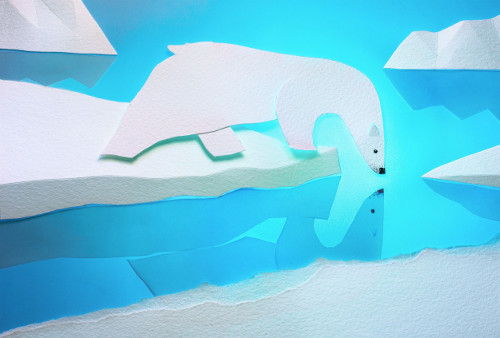
I shot a video of this process to share with you, because I find it really fun and beautiful to watch the light animate the art in real time:
Here’s another:
And one more!
Keep kicking, all, and thanks for letting me share my work here again!
A POLAR BEAR IN THE SNOW. Text copyright © 2020 by Mac Barnett. Illustrations copyright © 2020 by Shawn Harris. Illustrations reproduced by permission of the publisher, Candlewick Press, Somerville, MA. All other images reproduced by permisison of Shawn Harris.


A great example of matching the technique of art to the subject and tonality of the text, and doing so with great innovation. Thanks for showing how the magic works!
I love the book and the use of cut paper. Vellum is amazing in what it adds. Watching the process gave me new insight on presentation and getting the effect one wants. A great partnership in writing and illustration. A winner. Thanks.
What a fascinating process! Thank you for sharing.